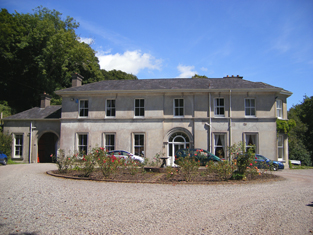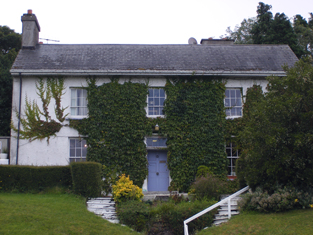Whitegate House
Houses within 5km of this house
Displaying 14 houses.
Houses within 5km of Whitegate House
Displaying 14 houses.
| House name | Description | |
|---|---|---|
| Corkbeg | The Penrose Fitzgerald Papers in the Boole Library document the building of a mansion house at Corkbeg in the 1820s. It was built to replace an earlier house mentioned by Wilson in 1786 as the seat of Robert Uniacke Fitzgerald. It was held in fee by the Fitzgeralds and valued at £65 in the early 1850s. By 1906 it was valued at £81. Bence Jones writes that the Fitzgeralds sold Corkbeg in the mid 20th century. The Irish Tourist Association survey notes that it functioned as a hotel for a few years. It was demolished in order to establish an oil refinery. | |
| Point House (Crosshaven) | Edward Sisk was leasing this house from the Puxley estate at the time of Griffith's Valuation, when it was valued at £10 10s.The house at the site is known as Point House and the National Inventory of Architectural Heritage suggests it was built in the mid-eighteenth century. |

|
| Trabolgan | Home of the Roche family for over three centuries. Held by Edmund Burke Roche in the mid 19th century and valued at £100. In 1912 acquired by the Clarke family, owners of the tobacco company in Bristol, manufacturers of Players cigarettes. Owned by the Clarkes until the 1940s when purchased by the Land Commission. The Irish Tourist Association survey noted that it was for sale in 1942. The house was demolished in 1982 and the demesne is now an activity holiday centre, see http://www.trabolgan.com/Home.aspx |

|
| Bennett's Court | The Bennetts were resident at Ballymore from the 18th century but this house dates from about the 1840s. At the time of Griffith's Valuation it was the residence of Joseph H. Bennett who held it in fee. The buildings were valued at £41. Owned by a religious order in the 20th century and now in use as a medical clinic. |

|
| The Priory | A house valuled at £17+ at the time of Griffith's Valuation and held by the Reverend Francis Newport from Joseph H. Bennett. The Reverend Newport's daughter married J. H. Bennett's nephew in 1865 and they eventually inherited Bennett's Court. |

|
| Ballymore House | The Hare family, Earls of Listowel, also held land in the townland of Ballymore in the 19th century. In 1814 the proprietor of Ballymore was the Honourable Mr Hare. In 1837 J.H. Bennett was resident at Ballymore House. This house appears to have been in the possession of the Honourable Robert Hare at the time of Griffith's Valuation when it was held from Joseph H. Bennett and valued at £15+. Robert Hare was a younger brother of the 2nd Earl of Listowel and married in 1840 Louisa French of Marino. Their son Robert Dillon lived at Ballymore. In 1906 John C. Bennett is given as the occupier and the mansion house was valued at £65. Bence Jones writes that post 1950 owners include the O'Donovans and Hecketts. |

|
| Cuskinny | A French home from the early 19th century, occupied by Savage French in 1814 and by his son Savage T.W. French in 1837 and in the early 1850s. The house was then valued at £32 and held from Bartholomew Verling and Thomas R. Sarsfield. IN 1894 Slater noted it as the seat of S. French. This property was still in the possession of the descendants of the French family in the 1970s. |

|
| Hadwell Lodge | Lewis records the Reverend Dr Austen as resident at Hadwell in 1837 [this may have been the nearby glebe house] and J. Penrose at Hadwell Lodge. In the early 1850s the Reverend Robert Austin occupied Hadwell Lodge. It was valued at £50 and held from William Gearin. By the 1890s this property had become known as Hadwell House. It is described as "in ruins" on the 1940 edition Ordnance Survey map. | |
| Aghada | J. Roche occupied this house in 1837. He built Aghada House and had a daughter who married [Henry] O'Brien of Whitepoint and they had a daughter who married her cousin William Roche. William Fitzgibbon was resident at Aghada House at the time of Griffith's Valuation when the house was valued at £35 and held from Henry O'Brien. It was the seat of William de Wilton R. Thackwell in 1894. http://www.archive.org/stream/barrymorerecords00barr/barrymorerecords00barr_djvu.txts | |
| Maryland House | The residence of Joseph Haynes in 1837 and the early 1850s, held by him from William Player at the time of Griffith's Valuation and valued at £20. A cornmill was located closeby. Maryland is no longer extant. | |
| Rose Hill | At the time of Griffith's Valuation Alexander McNab held Rose Hill House valued at £15 with 120 acres from the Marquess of Thomond. The National Inventory of Architectural Heritage shows a house at this location dating from the 1890s. |

|
| Rostellan | Seat of the Marquess of Thomond, occupied by him in in 1786 (Lord Inchiquin. It was at £79 in the early 1850s. Bought by Dr T.A. Wise after the Marquess's death in 1855, a lithograph of the house is included in the sale rental. Subsequently purchased by Sir John Pope Hennessy and mentioned by Slater as the residence of Lady Pope Hennessy in 1894. Occupied by Charles J. Engledew and valued at £112 in 1906. The Irish Tourist Association survey noted in the early 1940s that the roof and fittings had recently been removed and the land taken over by the Land Commission. No trace of the house remains now. |

|
| Mosestown | In 1786 Wilson notes a house on the left of Whitegate as the seat of Charles Allen. This may refer to the house labelled "Mosestown House" on the 1st edition Ordnance Survey map. At the time of Griffith's Valuation it was occupied by Edmund Roche, son of Francis Roche of Rochemount. The house was valued at £21 and held from Edmond B. Roche. Edmund was a distinguished soldier rising to the rank of Major General and married Anna Matilda, daughter of the Reverend Austen, of Hadwell Lodge. In 1894 Slater recorded a house known as Ballymonis as the seat of General Edmund Roche. Mosestown is labelled Ballymonis on the 25-inch Ordnance Survey map of the 1890s. It is no longer extant. | |
| Rochemount | The residence of a junior branch of the Roche family in the 19th century. Occupied by Francis Roche in 1814 and by John Webb Roche in 1837 and the early 1850s when the buildings were valued at £30. He held the property in fee. In 1894 Slater notes Rochemount as the seat of Francis W.A. Roche. There are still buildings extant at this site. |

